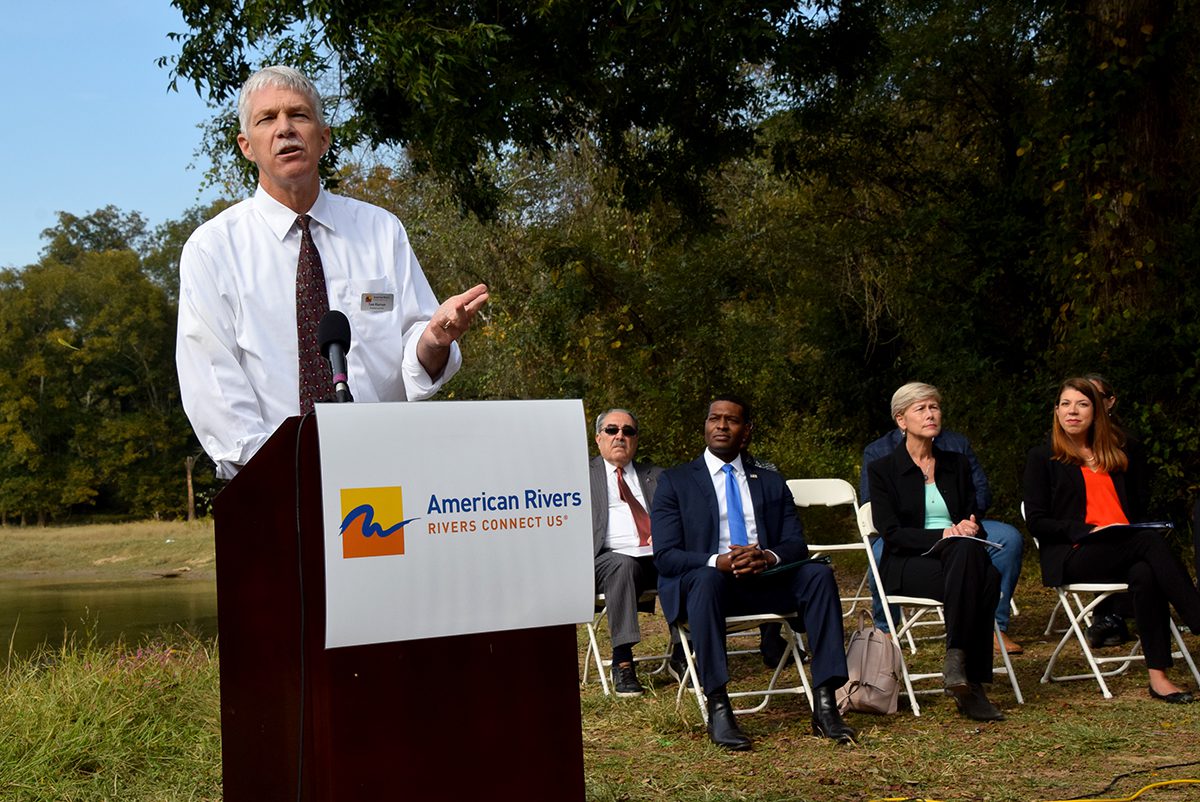
GOLDSBORO – River conservation organization American Rivers, based in Washington, D.C., announced Monday that it was honoring the Neuse River as its 2022 “River of the Year.”
The river has had a long, troubled history of pollution, and problems with nutrient pollution continue, especially from nonpoint sources – mainly runoff from developed areas.
Supporter Spotlight
Along with the Cape Fear River, American Rivers had included the Neuse at No. 7 on its Most Endangered Rivers of 2017 list, as well as in prior years, because of industrial agriculture waste within their basins. But the national recognition announced Monday during an event on the riverbank at Old Waynesborough Park in Goldsboro with congressional, legislative and regulatory officials and community and environmental advocates in attendance was to celebrate progress and serve as a call to action for clean water, said American Rivers President Tom Kiernan.
“It is because of the community, the state, the federal leadership that has worked so hard over the last several decades to improve the health of this river, improve the water quality of this river for the benefit of the people, the communities and nature in this region,” Kiernan said during the event.
Related: Nutrients in the water — too much of a good thing
Tuesday marked the 50th anniversary of passage of the Clean Water Act. But as 1st District Rep. G.K. Butterfield, D-N.C., noted during the event, a challenge to a key provision of the law is now before the Supreme Court.
As the EPA defines it, Section 401 of the Clean Water Act is a tool for states to protect water quality of federally regulated waters within their borders, in collaboration with federal agencies. Butterfield said the provision gives states authority to place conditions on permits and licenses for the construction and operation of any project that could harm rivers or streams.
Supporter Spotlight
The case, Sackett v. EPA, challenges methods used to define federal jurisdiction — Waters of the United States, or WOTUS. The case was argued Oct. 3.
Butterfield said that if Section 401 is struck down, “American families will lose protections and continue to face unclean water in some communities.”
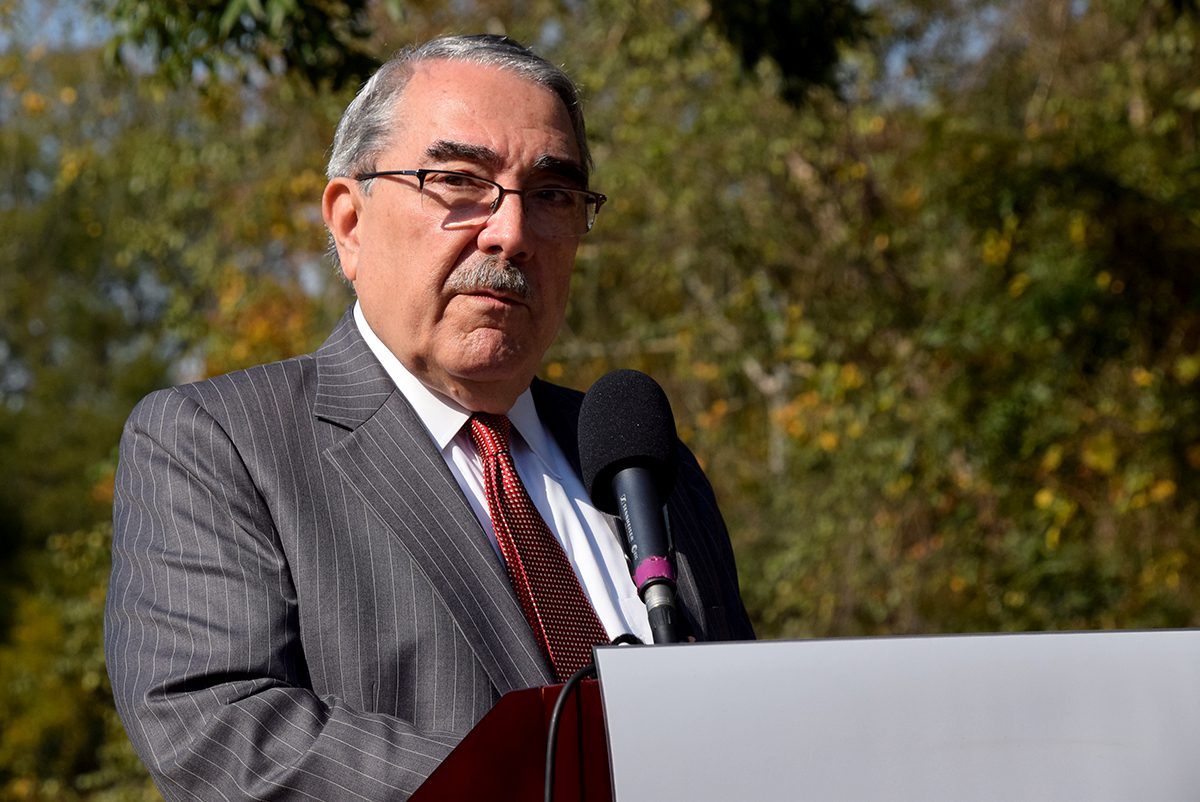
Butterfield said that some in Congress were drafting a resolution commemorating the Clean Water Act’s 50th year. “I will be supporting this legislation, and I’m confident that it will enjoy bipartisan support. And I pray that my successor will also support the resolution,” he said.
‘A profound effect’
Kiernan said the Clean Water Act had “a profound effect” on water quality in rivers and water bodies nationwide, including the Neuse River.
“It set in law the obligation to be good stewards of the environment and it set goals and expectations for specific communities on what they needed to do,” Kiernan said, adding that it was a good thing, “because in the mid-1990s, the Neuse River had toxic algae blooms that were sucking all the oxygen out of the river.
“We had fish kills, we had recreational opportunities that were lost because of the poor water quality. And not surprisingly, during that period, American rivers listed the Neuse on its most endangered rivers list five times back in the ’90s and 2000s. But backed by the Clean Water Act, the communities — you and political leaders in the state and in Washington, D.C., would not accept that fate for the Neuse.”
He said science pointed to excessive pollution coming from the wastewater treatment facilities and from untreated urban and rural agricultural runoff, and he praised the state and local officials for acting.
“You invested millions of dollars in wastewater treatment facilities, you protected the land along the river, you improved farming practices, and you began addressing the stormwater runoff problem. These efforts saw a dramatic improvement in the water quality.”
Kiernan said the case before the Supreme Court could end up restricting the Clean Water Act in ways that would remove protections from 350,000 acres of Neuse River wetlands.
“The Neuse is a success story that we must continue writing,” said Kiernan, who also applauded the work of Environmental Protection Agency Administrator Michael Regan, who was formerly secretary of the North Carolina Department of Environmental Quality, and Regan’s successor at DEQ, Elizabeth Biser.

Cultural connections
Regan, who hails from Goldsboro, said being back home was a reminder that he had grown up hunting and fishing in eastern North Carolina with his father and grandfather, and that experience had nurtured his passion for the outdoors and environmental stewardship.
“Rivers and streams across this country provide an opportunity for education, cultural connections, and recreation, while existing as magnificent natural resources central to the cities and towns that depend on them,” Regan said. “That’s why our work to preserve and protect and invest in these waters for the next generation is so vital.”
Regan said that not long ago, rivers were so polluted that fisheries collapsed, they were unsafe for recreation, and some were covered in oil slicks and regularly caught fire. He said that Tuesday he would be on the banks of the Cuyahoga River in Cleveland, Ohio, to commemorate the 50th anniversary of the passage of the Clean Water Act.
“As many of you know, the Cuyahoga River, which was dubbed River of the Year just a few years ago, was one of the major catalysts for the environmental movement that ultimately led to the Clean Water Act,” Regan said. “Like too many waterways across this country, in the 1950s and ’60s, the Cuyahoga River had fallen victim to years of unchecked pollution. I’m talking about the days when many of our rivers were seen as nothing more than dumping grounds for sewage and industrial waste.”
American Rivers had awarded previous River of the Year honors to the Cuyahoga River in 2019 and the Delaware River in 2020.
Regan said that during his travels across the country, he had seen firsthand the results of years of indifference and neglect and what that had done to the nation’s waterways, water systems and the people who rely on them. He called the recently passed bipartisan infrastructure law “the linchpin to the next 50 years of water progress in America.”
State of the river
Biser outlined her department’s mission to provide science-based environmental stewardship for the health and prosperity of all North Carolinians. “And we do that in many ways. On the regulatory side, we have permits to regulate what’s allowed to enter the river. The Neuse River in particular has been plagued by excesses in levels of nitrogen and phosphorus since the 1980s, risking aquatic life habitats and drinking water quality. And in response, as you’ve heard, today, we developed the Neuse nutrient strategy, a set of rules designed to equitably regulate sources of nutrient pollution in the basin.”
Those rules took effect in 1997 and have been updated over the years, “as a comprehensive strategy that takes into account impacts from wastewater, stormwater and agricultural sources,” Biser said.
“While parts of the river are still impaired, we’ve come a long way,” she said.
Biser said the state had completed the equivalent of 82 miles of stream mitigation, restored 10 square miles of wetlands and removed more than 1.5 million pounds of nitrogen from the water in the Neuse. “In case anybody’s wondering, that amount of nitrogen is equivalent to the same amount of weight as 287 pickup trucks,” Biser said.
She mentioned other programs and initiatives, including the North Carolina General Assembly’s funding of programs such as the statewide Flood Resiliency Blueprint.
“I’m grateful for Representative Bell’s leadership on this and for helping allocate $20 million that support that effort is going to make us better informed and target our decisions as a state so that we can have the maximum impact with dollars that we’re investing in communities,” she said, referring to state House Majority Leader Rep. John Bell, R-Wayne, who was also on hand for the event.
‘Going the wrong way again’
The state nutrient rules adopted in 1997 aimed to recover the Neuse River estuary within five years. The rules addressed wastewater discharges, cropland agriculture, stormwater runoff and established riparian buffer protections.
According to information DEQ provided Tuesday, nutrient loading to the estuary improved after the rules were enacted, but over time those gains were lost. Reductions in nitrate-nitrogen reaching the estuary were offset by organic nitrogen inputs, returning total nitrogen loading to levels seen before the rules. DEQ said the reasons were “complex and not entirely clear.”
Dr. Nathan Hall at the University of North Carolina Institute of Marine Sciences regularly monitors Neuse River water quality. He told Coastal Review Tuesday that yes, there was definitely progress between the early 1980s and 2000, “but since then things have started going the wrong way again.” He shared figures illustrating how nitrogen concentration trends in the river “are heavily driven by hydrology rather than nutrient management.”
State officials pointed to recent studies that have shown that a substantial increase in the frequency and severity of tropical cyclone activity such hurricanes and other big storms in coastal North Carolina driven by climate change played a significant role in the increased organic nitrogen reaching the Neuse River estuary.
Staff with the DEQ Division of Water Resources said rules addressing stormwater runoff from new development need to be strengthened. They said amendments to the Neuse stormwater rule that took effect in 2020 help, but further measures were likely needed, along with management actions to reduce runoff from existing developed lands that predated or otherwise were not addressed by current stormwater rules.
“Significant progress has been made in agricultural nitrogen loss reduction, and the agricultural community in the Neuse Basin consistently reaches its 30% reduction goal. However, the measurable effects of management changes and conservation practice implementation on overall in-stream nitrogen reduction may take years to develop due to the nature of non-point source pollution,” according to the North Carolina Department of Agriculture and Consumer Services 2022 annual report on the Neuse Agricultural Rule.
The division is in the process of a comprehensive review of management progress to date, watershed changes, current science and management recommendations going forward. That report is to be completed by April 2023.
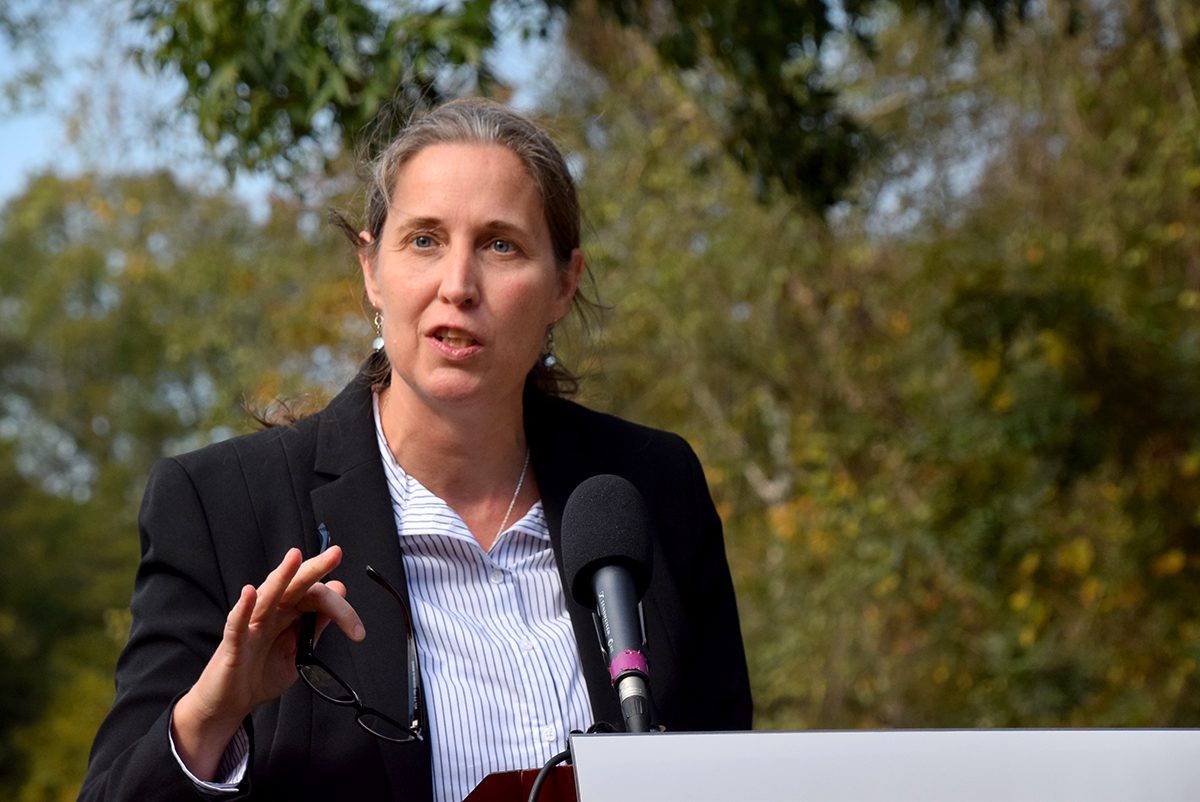
Need for greater investment
Sound Rivers Executive Director Heather Deck called the river “the lifeblood of our communities.” Deck began her advocacy career 20 years as the Pamlico-Tar Riverkeeper. She said that everyone can agree that access to clean water and healthy rivers was vital.
“We’ve come a long way since the early days of dumping toxins directly into the Neuse, but many still bear the burdens of pollution, outdated infrastructure, and flooding,” Deck said. “Working together to address these issues in our watershed, that work begins with our most vulnerable communities. What we need is greater investment in our communities on the river. And right now, right now we have a unique opportunity to make significant changes for the Neuse River, and all the people who rely on it, and to right the many environmental injustices that continue to stand.”
Deck said that river needs state and community leaders to prioritize investment in safeguarding residents from flooding and helping the Neuse watershed become resilient to climate change, “updating sewer infrastructure still starting in our most vulnerable communities on the Neuse, investing $20 million in the state swine buyout program to remove toxic pollution such as swine waste from flood-prone areas of the Neuse and its tributaries, and restoring funding to our regulatory agencies so that they’re fully staffed and equipped to enforce the protections for the Neuse watershed.”
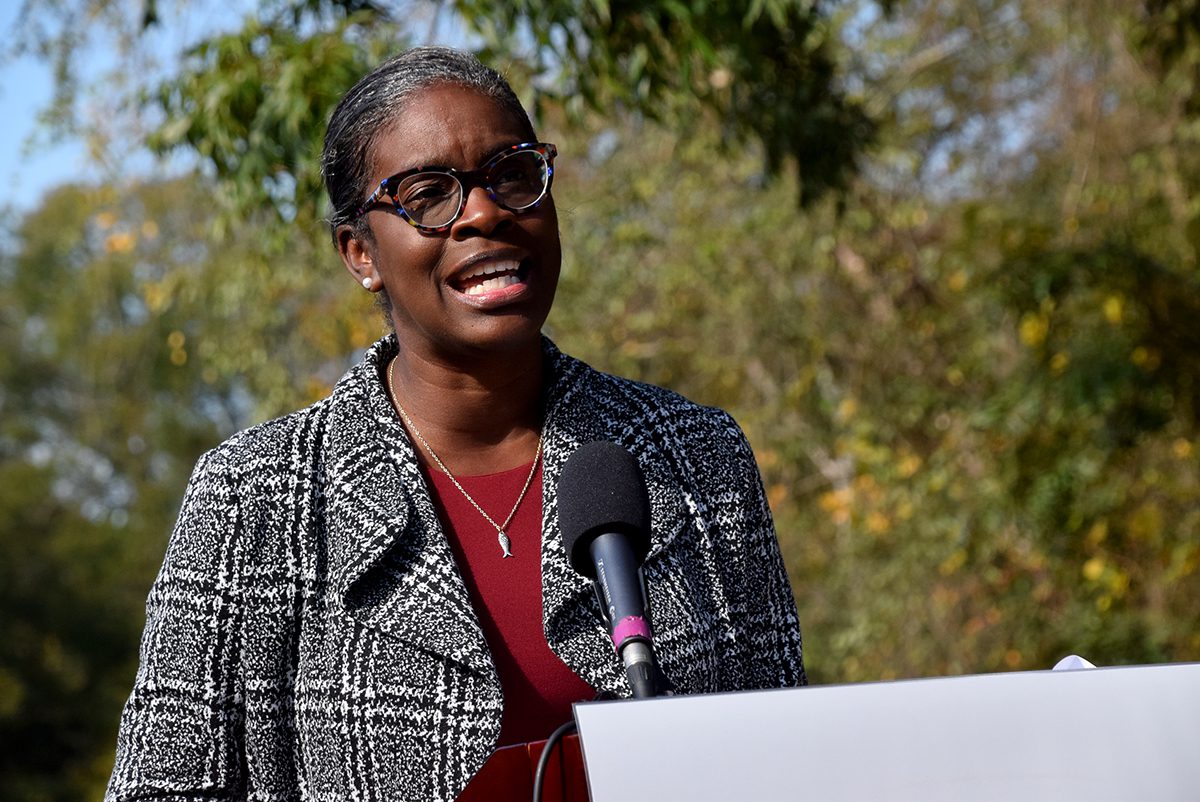
Pursuit of environmental justice
Deck called for community-focused executive action in the pursuit of environmental justice. “It’s our role to write 50 more years of progress into the next chapter of the Neuse River,” Deck said.
Dr. Dawn Baldwin Gibson is executive director of the Peletah Institute for Building Resilient Communities, a faith-based organization based in New Bern. She said the organization she and her husband founded in 2011 had fed thousands and assisted thousands more in getting back into homes after storms. The group had also led numerous projects in partnership with other faith organizations to build community resiliency in underserved areas. She said that in celebrating the American Rivers recognition, efforts to address climate impacts on the most vulnerable must continue.
“These are our neighbors who struggle every time there is a rain event by the impacts of flooding due to living in low-lying communities that are too often under resourced, that have lived on this river for decades and some for generations. We need the resources, the funding, the technical assistance to build our communities strong, resilient and equitable,” she said.
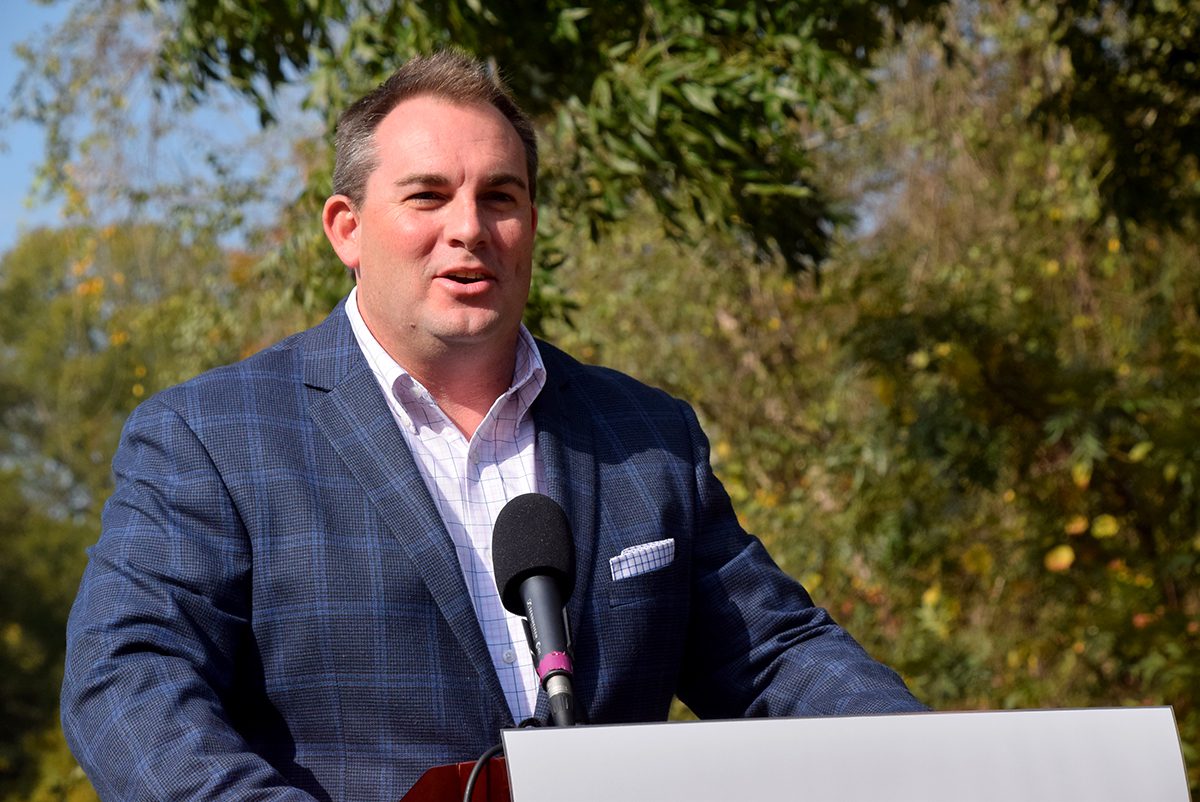
Rep. Bell told attendees that Wayne County had a “love-hate relationship” with the Neuse. He said residents are proud of the river and understand its economic importance. “But when we have disasters, hurricanes and storms that come in, this area floods. So we want to do everything we can to, at the state level, to mitigate that damage — to mitigate the property damage, mitigate the business damage to our economic engines and mitigate the loss of life — and that’s why your state in a bipartisan fashion has committed hundreds of millions of dollars to that effort.”
Second District Rep. Deborah Ross, D-N.C., noted that nearly 2.5 million people live within the Neuse River basin, “including communities I represent in Wake County, from Goldsboro, to Raleigh, millions of people rely on this river and its tributaries for clean water. They walk the miles of hiking trails that wind around this beautiful area, and they use the river to power economic growth throughout the state,” she said.







